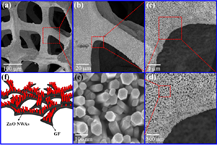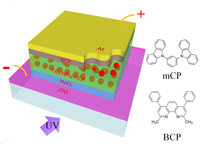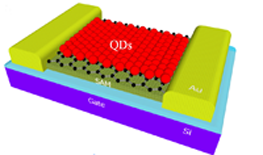Performance enhancement is enabled by the use of low cost, hybrid inorganic/organic nanostructured materials. Advantages due to a high surface to volume ratio for better light absorption and an inherent large internal gain are typically hindered by surface defects and slow carrier transport mechanisms. We’ve developed devices with strategic use of inorganic/organic core shell structures which provide surface passivation and improved carrier transport.
read more »
Innovative device structures take advantage of the synergistic properties of nanocomposite materials. The nature of processing for inorganic/organic hybrid materials allows for deposition of devices on any substrate. The combination of core-shell nano-bio hybrid materials for use in light detectors, solar cells, artificial photosynthesis components, photocatalytic devices, and flexible supercapacitors are investigated and/or in close reach of current research projects in the Sawyer Lab.
read more »
Ultraviolet light emitting diodes and photodetectors are used for microbial contamination detection and identification on surfaces, in air, and in water. Remote detection requires ultra-sensitve sensors. Biological and chemical sensors integrate organic recognition layers with inorganic signal transduction layers. Research in sensor systems is a highly collaborative, interdisciplinary activity. Applications continue to expand as innvoations in hybrid materials and devices develop.
read more »




